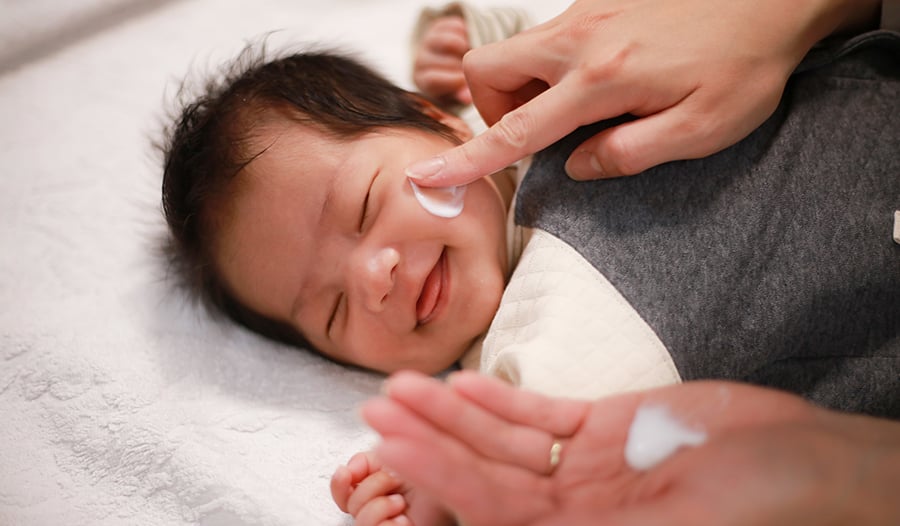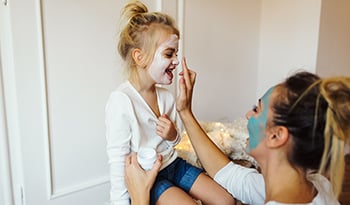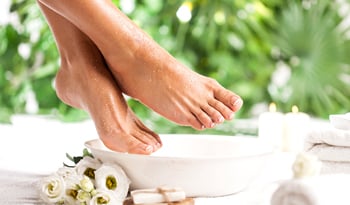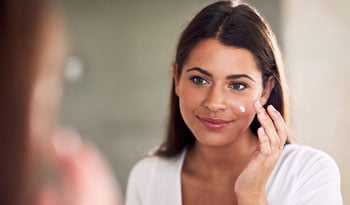Tips and Products for Baby Skincare: A Comprehensive Guide
DISCLAIMER:This blog does not intend to provide diagnosis...
- In this article:
- How to Cleanse Baby Skin
- How to Hydrate Baby Skin
- How to Protect Baby Skin
- Takeaway

A baby has delicate skin needs to be cared for in the gentlest ways. Caring for a baby’s skin often involves keeping the skin clean, making sure the skin is hydrated, and protecting the skin.
How to Cleanse Baby Skin
Commercial products for washing an infant often have synthetic chemicals that many parents may not be comfortable using. For example, a wide variety of baby soaps have synthetic fragrances. Studies show that over one-third of individuals exposed to synthetic fragrances in the environment experience adverse effects. Multiple studies have found that synthetic fragrance use may be linked to various health problems, including migraines, asthma attacks, and skin rashes.
Other baby wash products may contain hidden chemicals like phthalates. Phthalates are chemicals used in the production of plastics. Studies have linked phthalate exposure to disruption of the body’s hormones. One study assessed the status of 9 phthalates in 163 infants. The study found that 81% of infants had been exposed to 7 or more phthalates. The study suggested that this was due to topical infant care products like baby lotions and shampoos.
To avoid synthetic chemicals, some parents may opt out of baby shampoos and wash their infant with water alone. One study found that washing babies with water alone had the same effect as using a baby wash. The study focused on the baby wash’s effect on transepidermal water loss (TEWL).
TEWL is the amount of water that evaporates from the skin’s surface into the environment. It is used in many skin studies to assess skin hydration. While losing water through the skin is a natural process that is tightly regulated, certain conditions, such as the use of topical products, can increase TEWL. Increased
TEWL means that the integrity of the skin barrier is compromised. This can lead to skin damage and an increase in infections.
Castile Soap
While washing with water alone is a valid choice, parents may still want a gentle cleansing product for their children. Castile soap is just the cleansing product parents may be looking for. Castile soap is a gentle, plant-based soap that is safe, all-natural, and chemical-free. Unscented castile soap is gentle enough to be a cleansing agent for infants and adults alike. This is because castile soap is mild and has a natural but subtle foaming action that helps to remove dirt and grime without disturbing the pH of an infant’s skin.
When it comes to bathing, studies suggest that infants don’t need to be washed often, especially when firstborn. Research indicates that delaying the newborn bath for the first 24-48 hours of life may help to increase the bond between the parents and the child. Delayed bathing may also help to improve the chances of successful breastfeeding.
Current recommendations suggest that newborns are washed with water alone until they reach 4-6 weeks old. Gentle liquid soaps, like castile soap, can then be introduced.
Babies may be washed 3 times a week. Research indicates that infants born prematurely can be washed every 4 days without any adverse effects, such as increased skin colonization of harmful bacteria.
How to Hydrate Baby Skin
Because a baby’s skin is so delicate, it must maintain perfectly balanced hydration to stay healthy and functional.
When it comes to hydration, a baby’s skin is unique compared to that of an adult. This is because of the way a baby’s skin must adapt upon birth. During the third trimester of pregnancy, the fetus is enveloped by a special covering called the vernix caseosa. This covering is a mixture of protein and fats that helps the skin transition from the mostly aqueous environment of the uterus to the outside world.
Upon birth, the skin of a newborn baby experiences a major change. Because the environment outside of the uterus is not aqueous, the newborn’s skin must adjust by increasing its hydration. Studies have found that skin hydration in a newborn baby increases significantly upon birth. This increase in skin hydration continues for up to 90 days after birth.
The skin must maintain hydration so that it functions properly. The skin can become dry and inflamed without adequate hydration or lose its integrity. An example of dry and inflamed skin is atopic dermatitis or eczema. Studies suggest that up to 28% of infants develop eczema within the first 6 months to year of life. Eczema is a skin condition involving itching, dryness, and a rash. This inflammatory skin condition may also involve blistering and skin infections due to excess scratching and a weakened skin barrier.
Ceramides
Studies show that ceramides may help to improve eczema. Ceramides are fatty waxlike molecules that the skin produces naturally. Skin cells may comprise 30%–50% ceramides, which help to maintain skin hydration and protect the skin barrier. One placebo-controlled study involving a ceramide-based cream and skin dryness found that one topical application could increase skin hydration over 24 hours. This didn’t happen with the placebo.
The study also found that the ceramide-based cream didn’t cause skin irritation and protect against skin injury. Another study involving 50 individuals found that topical ceramide use for 4 weeks improved sensitive skin and eczema. For infants with eczema, using a ceramide-based cream at least once daily may help reduce symptoms. Ceramides may also have anti-aging properties that help a baby’s skin stay youthful into adulthood.
While studies suggest that ceramide use may improve eczema, none suggest that topical ceramide use may help to prevent eczema. This is because studies suggest that eczema may have some connection with an altered gut microbiome. While many parents don’t necessarily see a connection between the gut and the skin, maintaining a healthy gut microbiome may help to protect a baby’s skin.
How to Protect Baby Skin
Protecting a baby’s skin can seem challenging because it is so fragile. Studies suggest that a connection exists between the gut microbiome and skin health. This gut-skin connection may be at play in skin disorders like eczema.
Probiotics
Studies suggest that an infant probiotic supplement may help to reduce eczema in children under 3 years of age. One meta-analysis found that probiotics containing Lactobacillus and Bifidobacterium helped to prevent eczema better than placebo.
Other studies suggest that probiotic use may even improve diaper dermatitis in infants. Many infants develop diaper dermatitis, diaper rash throughout diapering. Diaper rash is quite common. Studies suggest that up to 25% of skin-based healthcare visits in the first year of life are due to diaper rash. Diaper rash is a condition in which the skin covered by a diaper becomes inflamed. Studies suggest that diaper rash has a number of causes. These include increased skin exposure to wetness, higher skin pH due to urine contact, and exposure to microorganisms commonly found in stool.
Infection with Candida albicans, or a yeast infection, is also a common cause of diaper rash in infants. Research indicates that diaper rash may be partly avoided by using absorbent diapering materials to protect a baby’s skin. Creams to improve the barrier between the skin and the diaper may also effectively reduce the occurrence of diaper rash.
Calendula
One study involving 73 healthy children under 2 years of age found that using calendula or olive oil-based ointments helped to improve mild diaper rash. Calendula is an herb mainly used for healing skin wounds and soothing irritated skin. Studies involving calendula ointment for diaper rash find the improvement within days of application. One study involving 66 infants under the age of 3 found that calendula ointment used 3 times a day for 10 days markedly improved diaper rash symptoms.
Bentonite Clay
Research indicates that a bentonite clay-based cream may help improve the condition faster than calendula for infants with more severe diaper rash. One double-blind, randomized, controlled study focused on 100 infants between 6 months to 1 year old with diaper rash. Infants were separated into two groups. One group received a bentonite clay-based cream, while the other received a calendula-based cream. Some 88% of the group that received the bentonite clay-based cream saw an improvement in diaper rash symptoms within 6 hours of application, while 54% of the calendula group saw the same. The study also found that after 3 days, 86% of the infants in the bentonite clay group had a complete recovery from diaper rash, while only 52% of those in the calendula group did.
Bentonite clay is a natural moisture-absorbing clay that may also have detoxifying properties. Studies suggest that bentonite clay may help promote the longevity of the skin by improving collagen production. To use bentonite clay for diaper rash, mix a small amount of the clay with warm water to make a paste. Apply the paste to the areas of the diaper rash and let the clay dry. Once the clay has dried, remove it with a soft cloth and warm water.
Takeaway
Caring for a baby’s skin doesn’t have to be a challenge. With gentle but effective products and a sound regimen, a baby’s skin can be healthy and youthful for years.
References:
- Afsar FS. Skin care for preterm and term neonates. Clin Exp Dermatol. 2009;34(8):855-858. doi:10.1111/j.1365-2230.2009.03424.x
- Dimitratos SM, Brown H, Shafizadeh T, Kazi S, Altmann T, Ostrer B. Symptomatic relief from at-home use of activated Bifidobacterium infantis EVC001 probiotic in infants: results from a consumer survey on the effects on diaper rash, colic symptoms, and sleep. Benef Microbes. 2021;12(4):27-34. doi:10.3920/BM2020.0229
- Draelos ZD, Raymond I. The Efficacy of a ceramide-based cream in mild-to-moderate atopic dermatitis. J Clin Aesthet Dermatol. 2018;11(5):30-32
- Givol O, Kornhaber R, Visentin D, Cleary M, Haik J, Harats M. A systematic review of Calendula officinalis extract for wound healing. Wound Repair Regen. 2019;27(5):548-561. doi:10.1111/wrr.12737
- Hlisníková H, Petrovičová I, Kolena B, Šidlovská M, Sirotkin A. Effects and mechanisms of phthalates' action on reproductive processes and reproductive health: a literature review. Int J Environ Res Public Health. 2020;17(18):6811. Published 2020 Sep 18. doi:10.3390/ijerph17186811
- Johnson E, Hunt R. Infant skin care: updates and recommendations. Curr Opin Pediatr. 2019;31(4):476-481. doi:10.1097/MOP.0000000000000791
- Kamer B, Pasowska R, Dółka E, Blomberg A, Rotsztejn H. Prevalence of atopic dermatitis in infants during the first six months of life: authors' observations. Postepy Dermatol Alergol. 2013;30(5):277-281. doi:10.5114/pdia.2013.38355
- Lavender T, Bedwell C, Roberts SA, et al. Randomized, controlled trial evaluating a baby wash product on skin barrier function in healthy, term neonates. J Obstet Gynecol Neonatal Nurs. 2013;42(2):203-214. doi:10.1111/1552-6909.12015
- Lund C. Bathing and beyond: current bathing controversies for newborn infants. Adv Neonatal Care. 2016;16 Suppl 5S:S13-S20. doi:10.1097/ANC.0000000000000336
- Mahmoudi M, Adib-Hajbaghery M, Mashaiekhi M. Comparing the effects of bentonite & calendula on the improvement of infantile diaper dermatitis: A randomized controlled trial. Indian J Med Res. 2015;142(6):742-746. doi:10.4103/0971-5916.174567
- Mahmud MR, Akter S, Tamanna SK, et al. Impact of gut microbiome on skin health: gut-skin axis observed through the lenses of therapeutics and skin diseases. Gut Microbes. 2022;14(1):2096995. doi:10.1080/19490976.2022.2096995
- Martin PE, Koplin JJ, Eckert JK, et al. The prevalence and socio-demographic risk factors of clinical eczema in infancy: a population-based observational study. Clin Exp Allergy. 2013;43(6):642-651. doi:10.1111/cea.12092
- Moosavi M. Bentonite Clay as a Natural Remedy: A Brief Review. Iran J Public Health. 2017;46(9):1176-1183.
- Panahi Y, Sharif MR, Sharif A, et al. A randomized comparative trial on the therapeutic efficacy of topical aloe vera and Calendula officinalis on diaper dermatitis in children. ScientificWorldJournal. 2012;2012:810234. doi:10.1100/2012/810234
- Prasad HR, Srivastava P, Verma KK. Diaper dermatitis--an overview. Indian J Pediatr. 2003;70(8):635-637. doi:10.1007/BF02724253
- Sathyanarayana S, Karr CJ, Lozano P, et al. Baby care products: possible sources of infant phthalate exposure. Pediatrics. 2008;121(2):e260-e268. doi:10.1542/peds.2006-3766
- Sharifi-Heris Z, Farahani LA, Haghani H, Abdoli-Oskouee S, Hasanpoor-Azghady SB. Comparison the effects of topical application of olive and calendula ointments on Children's diaper dermatitis: A triple-blind randomized clinical trial. Dermatol Ther. 2018;31(6):e12731. doi:10.1111/dth.12731
- Spada F, Barnes TM, Greive KA. Skin hydration is significantly increased by a cream formulated to mimic the skin's own natural moisturizing systems. Clin Cosmet Investig Dermatol. 2018;11:491-497. Published 2018 Oct 15. doi:10.2147/CCID.S177697
- Steinemann A. Fragranced consumer products: exposures and effects from emissions. Air Qual Atmos Health. 2016;9(8):861-866. doi:10.1007/s11869-016-0442-z
- Steinemann A. Health and societal effects from exposure to fragranced consumer products. Prev Med Rep. 2016;5:45-47. Published 2016 Nov 14. doi:10.1016/j.pmedr.2016.11.011
- Zheng H, Liang H, Wang Y, et al. Altered Gut microbiota composition associated with eczema in infants. PLoS One. 2016;11(11):e0166026. Published 2016 Nov 3. doi:10.1371/journal.pone.0166026

 By Dr. Candace Mathers, N.D.
By Dr. Candace Mathers, N.D.


